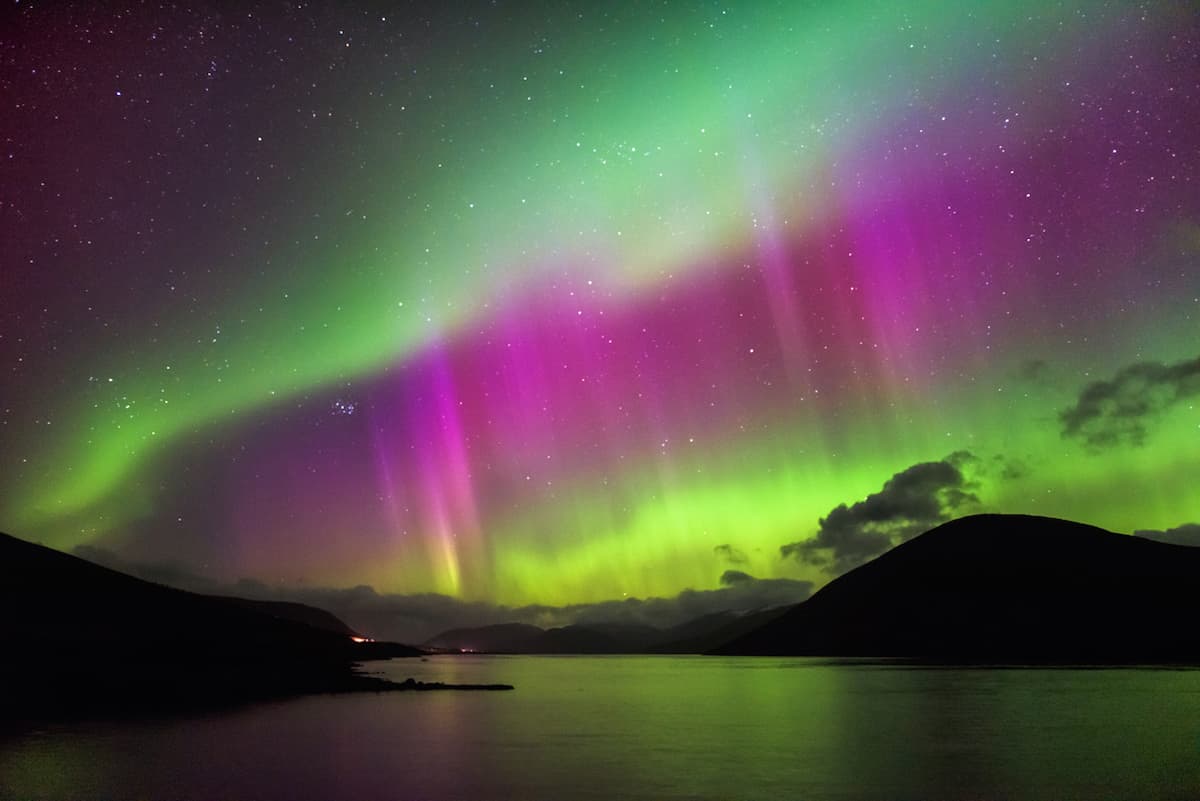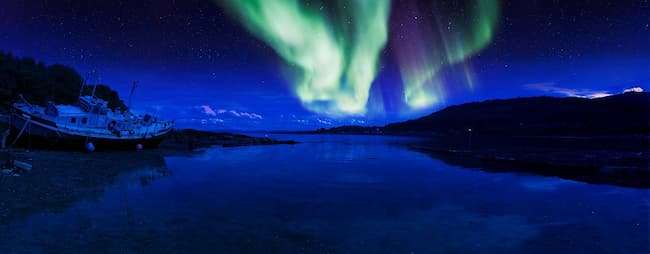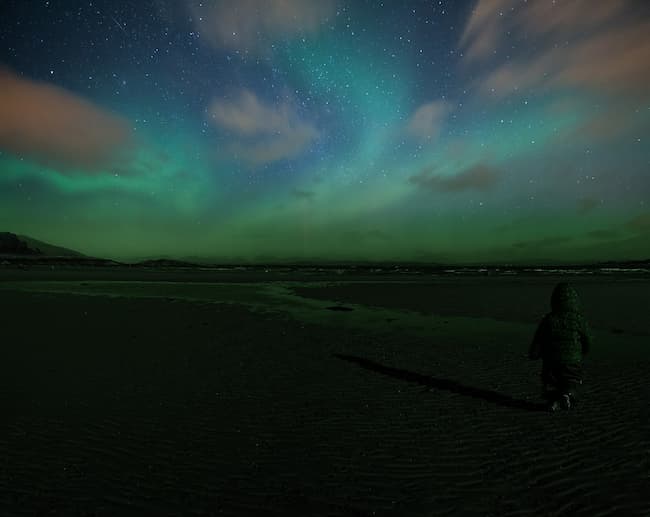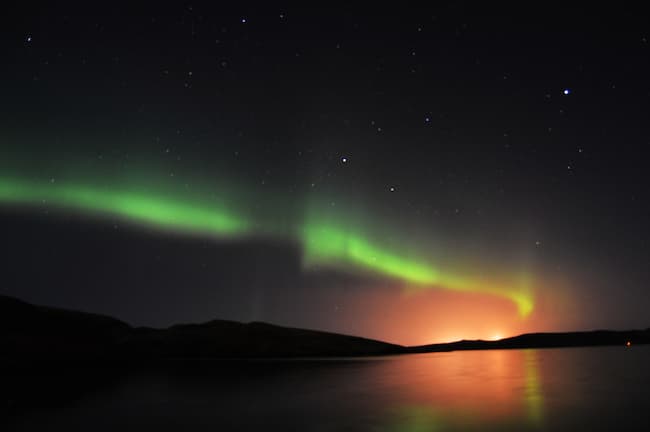The Northern Lights in Scotland
Seeing the Northern Lights in Scotland is like watching a beautiful light show being displayed against a black velvet sky. It's an unforgettable experience.
This natural phenomenon adds a splash of magic to some of the coldest and darkest nights of the year.
The Northern Lights (also known as the Aurora Borealis) could be described as a naturally-occurring light show, and are the result of interaction between solar wind and magnetically charged particles in the Earth's atmosphere.
While science is the explanation, the result is pure art, supplied by nature itself.
 Spectacular Northern Lights over Loch Glascarnoch, Scottish Highlands
Spectacular Northern Lights over Loch Glascarnoch, Scottish HighlandsIn theory, the Northern Lights/Aurora Borealis can be seen from almost anywhere in the UK at some point during the year.
In reality, you need a very dark sky and specific meteorological conditions in place in order to see them with the naked eye, and the further north you are the better your chances.
- Where can you see the Northern Lights in Scotland?
- When is the best time time to see the Northern Lights in Scotland?
- What do the Northern Lights look like?
Don't put all your eggs in one basket
Just a word of warning.... I'd suggest NOT planning a vacation to any area/location in Scotland with the sole purpose of seeing the Northern Lights because, as with any natural phenomenon, there are no guarantees that they will put on their magic show at any specific place, or at any specific time!
Luckily the locations where you're most likely to see the Lights are also packed full of other interesting places to visit, historical sights to see, gorgeous scenery to enjoy, food to eat and so much more.
If you choose your vacation spot with an eye to all it can to offer, and with the hope that the icing on the cake will be to see the Northern Lights, then you'll have a wonderful trip regardless.
At times the lights are not strong enough to be seen by the naked eye, or are so brief that you can easily miss them, but, if you're lucky enough to be in the right place at the right time it's an experience you will always remember.
FAQ about the Northern Lights in Scotland
If you'd like to experience the Aurora Borealis during a visit to Scotland, here are some tips that will help you figure out where, and when, to visit.
 Northern Lights over beach on the Isle of Mull, Scotland
Northern Lights over beach on the Isle of Mull, ScotlandWhere can you see the Northern Lights in Scotland?
The best places to see the Northern Lights in Scotland are in the far northern part of the country.
Although not within the Arctic Circle, Scotland is on the same latitude as some parts of Norway and Alaska,
Because the type of solar activity that triggers the northern lights is strongest at the north pole, it makes sense that the farther north you are in Scotland the more likely you are to see them.
On the mainland, the best areas for viewing are on the far north, and northeast or northwest coastlines. Approximately from the Caithness area down past Aberdeen.
If the Aurora Borealis is particularly strong, you may even be able to see it from as far south as Edinburgh.
Best places to try would be Arthur's Seat (the highest spot in the Royal Park, about one mile east of the city center), Calton Hill (less than a mile northwest of Arthur's Seat, just beyond the Princes Street), or Blackford Hill (two miles south of Edinburgh City Center).
The western coast of northern Scotland is also a viable option, from Durness down past Lochinver and Ullapool, and potentially as far south as Fort William.
The islands off the north/northwest coast are solid choices if you're planning a trip where you hope to catch a glimpse of the Aurora Borealis.
The Shetland Islands are a favorite spot for those hoping to catch a glimpse of the Northern Lights in Scotland. These islands are actually closer to the Arctic Circle than they are to London, and the closest part of the UK to the North Pole.
The Isle of Skye, off the northeast coast of Scotland is also a good place to visit if you're hunting the Aurora Borealis.
Here's a list of some of the best places to see the Northern Lights when visiting Scotland:
Scottish Mainland
Northeast and coastline. Including cities/areas such as:
- Aberdeenshire
- Angus
- Caithness
- Moray
- Perthshire
Northwest and coastline. Including cities/areas such as:
- Durness
- Fort William
- Lochinver
- Ullapool
- Wester Ross Coastal Trail
Inland:
- Cairngorms National Park (try the Glenlivet, Tomintoul and Aviemore areas)
- Galloway Forest Park in Dumfries & Galloway
- Loch Glascarnoch
Scottish Islands
- Isle of Skye
- Inner Hebrides (especially Isle of Mull and the Isle of Coll)
- Orkney (especially the island of North Ronaldsay)
- Outer Hebrides (especially the Island of Lewis & Harris and North Uist)
- Shetland Islands
 The Northern Lights on the Isle of Mull, Scotland
The Northern Lights on the Isle of Mull, ScotlandWhatever location you choose, when you're out at night looking for those gorgeous dancing lights, be sure to stay away from cities and towns as much as possible.
You need dark skies and as little artificial light sources as possible in order to see them well, or even at all sometimes.
Darksky locations
Some of the best places to view the Northern Lights in Scotland are designated 'darksky' locations.
This basically means that light pollution is at a minimum and the skies surrounding these areas are naturally, and beautifully, dark, making it much easier to see the stars and other natural meteorological phenomenon.
The Isle of Skye is home to nine Dark Sky Discovery Sites where artificial light sources are restricted.
The Inner Hebridean Isle of Coll, and the island of North Ronaldsay in Orkney, are two of only three designated International Dark Sky Islands in the world.
Darksky.org is an international organization whose aim is to raise public awareness of light pollution in today's world, and the negative effect it has on the environment, wildlife, climate and human race.
When can you see the Northern Lights in Scotland?
When you're visiting Scotland with a hope of seeing the Aurora Borealis, WHEN you go is just as important as WHERE you go!
Because you need the darkest possible skies in order to see the them, the best time to visit Scotland with the hope of catching sight of the Northern Lights is late Fall through early Spring.
Because of it's location, Scotland has long, light days during and short nights during the summer, but in mid-winter it can be dark for as long as 18 hours at times.
October, through March is the recommended time frame according to locals, experts and frequent Northern Lights viewers, and within that window cold, clear (it doesn't have to be totally cloudless but you need to be able to see the stars), nights between mid December and late January may offer up the best opportunities.
One other tip is to avoid nights where there is a full moon, or one that is almost full, as it's light can interfere with your ability to see the Northern Lights.
So as not to mess with your dark/light night time vision, if you need extra light choose something that emits red, rather than yellow/white light, such as this flashlight or headlamp.
If you're really committed to giving seeing the Northern Lights your best shot be prepared to be patient, and be prepared.
Many of the best viewing spots are isolated, and at the appropriate time of year can be bitterly cold.
Dress appropriately, have snacks and drinks handy and, although the most likely time to see the Northern Lights is between 9:00 pm and midnight, be prepared to stay awake longer, possibly even into the early morning hours as peak viewing time can extend until 2:00am or even later.
Be vigilant and pay attention to the skies, looking towards the north. Sometimes the Northern Lights can be faint, or fleeting, or both, and you don't want to miss them because you were napping or chatting.
Although often once the Aurora Borealis appears the show gets brighter, and stronger, over a period of time and you're likely to see the colors rippling or flaring, before eventually fading back into the darkness.
What do the Northern Lights look like?
The Northern Lights, aka the Aurora Borealis, can look very different at different times, and in different places. They're both ethereal and unpredictable.
 Northern Lights on the Shetland Islands in Scotland
Northern Lights on the Shetland Islands in ScotlandThe classic image of swirling, dancing, ribbons or a horizon-wide curtain of rainbow hued light, are the Northern Lights at their finest, and you absolutely may be lucky enough to experience them in all their finery!
However, they can also appear as little more than a subtle glow in the night sky, or even be invisible to the naked eye at times.
There are six different forms that the lights of the Aurora Borealis can take, but the most common are bands (ribbon-like), arcs (rainbow-like curves) and pillars (vertical streaks or bars).
The good thing is that even if you're not lucky one night, or at one point in a night, chances are you'll get a second chance, or several, over a period of days, and the lights will live up to your expectations at some point.
For the Aurora Borealis to be active it needs increased solar activity. Checking out the Aurorawatch UK website is a good way to find out when there may be activity, and where. They also have a cell phone app you can use on the go and you can follow @AurorawatchUK on Twitter.
A Northern Lights show may last anywhere from a couple of minutes, to a couple of hours, with the most common timeframe being somewhere between ten and thirty minutes.
You'll want to give your eyes a little while to adjust to the darkness, and avoid bright headlights, flashlights or sources of light. They'll interfere with your ability to see colors or movement in the sky.
Even if your view of the Northern Lights seems to be just a hazy white or pale green glow, take photos of it anyway!
Your camera will be much more effective at catching the colors than your eye will because our eyes don't do well at determining color in the dark, they're more likely just to see it as white.
When trying to take photos of the Northern Lights on a dark night your best bet is to use a good camera, or in a pinch you could use a cell phone that is known to work well in low lights.
You need a long exposure time (at least thirty seconds or so), and having some kind of well lit object in the foreground will help with focus and clarity.
If you'd like to see some absolutely gorgeous, professionally taken photographs of Scotland's night sky that includes shots of the Northern Lights as well as many other stunning compositions, check out scotlandsnightsky.com here.
what color are the northern lights in scotland?
The Northern Lights can be any color from a very faint, hazy white or gray, through rainbow hues, all the way to a vibrant red.
According to regular Northern Lights viewers in Shetland, the most common color seen is green (this makes sense because the human eye sees the green/yellow end of the color spectrum most easily in the dark). This accounts for approximately 60% of sightings.
The second commonly seen color of Northern Lights in a multi-colored rainbow-type mixture.
In third place are colors like pink, blue or purple, and finally red, which is the rarest of all Northern Lights colors, accounting for only about 1% or sightings.
Scottish Northern Lights Folklore
Shetland and Orkney are some of the most popular viewing spots for Northern Lights in Scotland, and for good reason.
Their beautiful and magical displays have been seen by islanders for centuries, and they even have their own name for them. They call them the 'Mirrie Dancers'.
The name comes from the Shetland and Orkney word 'mirr' meaning 'to shimmer, quiver or tremble' and the dancers comes from the way the lights twirl and shimmy across the sky.
In other parts of Scotland the Northern Lights are called 'The Nimble Folk', the name coming from the Scottish Gaelic word 'Na Fir Chlis' meaning 'quick, nimble men'.
In both cases, the Northern Lights are seen as sky dancers of the magical kind, and when you see them yourself you can understand why.
- Home
- Facts About Scotland
- The Northern Lights in Scotland